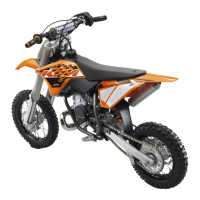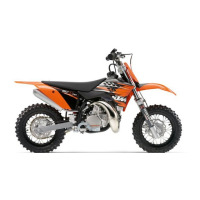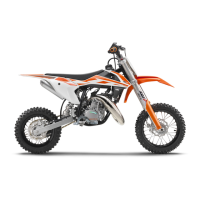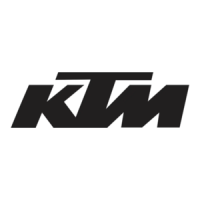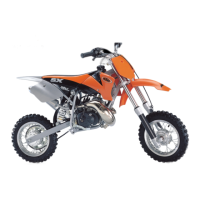Why KTM Motorcycle engine does not speed up?
- GGene MooreJul 30, 2025
If your KTM Motorcycle's engine won't speed up, one potential cause is loose carburetor jets. To address this, check and set the carburetor components.
Why KTM Motorcycle engine does not speed up?
If your KTM Motorcycle's engine won't speed up, one potential cause is loose carburetor jets. To address this, check and set the carburetor components.
Explains symbols used in the manual for clarity and safety.
Describes typographical formats for better document understanding.
Defines proper vehicle use, warns against misuse, and outlines general safety.
Details safety instructions and explains different levels of risk and associated symbols.
Warns against tampering with noise control systems and provides safe operation guidelines.
Emphasizes protective clothing and outlines rules for performing work on the vehicle.
Addresses environmental responsibility and the importance of the owner's manual.
Covers warranty, approved parts, and service requirements for optimal operation.
Illustrates key components of the motorcycle for easy identification.
Details the location of VIN, type label, and engine number for registration and service.
Explains the function and operation of hand levers, throttle, and kill switch.
Details the operation of fuel and oil tank caps and related systems.
Guides on initial setup, rider preparation, and proper engine break-in procedures.
Outlines essential checks before riding and basic operational procedures.
Covers starting the vehicle, beginning to ride, and fundamental riding practices.
Details how to apply brakes correctly and procedures for stopping and parking.
Lists scheduled maintenance tasks and their intervals based on operating hours.
Details recommended maintenance tasks beyond the required schedule.
Covers adjusting suspension settings for rider weight and terrain conditions.
Provides detailed instructions for adjusting shock absorber compression and rebound damping.
Guides on checking and adjusting fork air pressure and rebound damping.
Details procedures for lifting the motorcycle and basic chassis maintenance.
Covers fork protector, fork legs, and triple clamp service procedures.
Explains shock absorber removal/installation and seat removal/mounting.
Guides on air filter maintenance and servicing the main silencer.
Explains how to check brake lever play, position, and brake disc condition.
Covers checking and adding brake fluid and inspecting brake linings.
Details checking and adjusting foot brake lever travel and basic position.
Covers procedures for removing/installing wheels and checking tire condition and pressure.
Explains how to check and correct spoke tension for wheel integrity.
Guides on checking coolant level, antifreeze, and performing system maintenance.
Explains adjusting throttle cable play and carburetor idle settings for optimal performance.
Details the procedure for adjusting the engine's idle speed via the carburetor.
Covers checking the clutch setting and adjusting it for proper engagement.
Details procedures for checking and changing engine oil and gear oil.
Provides instructions for removing and installing the motorcycle's carburetor.
Outlines proper methods for cleaning and maintaining the motorcycle's appearance.
Guides on preparing the motorcycle for long-term storage and for use after storage.
Lists common problems, potential causes, and recommended actions for troubleshooting.
Provides essential technical data for engine, chassis, fork, and other components.
Lists chassis tightening torques for various fasteners and components.
Explains symbols used in the manual for clarity and safety.
Describes typographical formats for better document understanding.
Defines proper vehicle use, warns against misuse, and outlines general safety.
Details safety instructions and explains different levels of risk and associated symbols.
Warns against tampering with noise control systems and provides safe operation guidelines.
Emphasizes protective clothing and outlines rules for performing work on the vehicle.
Addresses environmental responsibility and the importance of the owner's manual.
Covers warranty, approved parts, and service requirements for optimal operation.
Illustrates key components of the motorcycle for easy identification.
Details the location of VIN, type label, and engine number for registration and service.
Explains the function and operation of hand levers, throttle, and kill switch.
Details the operation of fuel and oil tank caps and related systems.
Guides on initial setup, rider preparation, and proper engine break-in procedures.
Outlines essential checks before riding and basic operational procedures.
Covers starting the vehicle, beginning to ride, and fundamental riding practices.
Details how to apply brakes correctly and procedures for stopping and parking.
Lists scheduled maintenance tasks and their intervals based on operating hours.
Details recommended maintenance tasks beyond the required schedule.
Covers adjusting suspension settings for rider weight and terrain conditions.
Provides detailed instructions for adjusting shock absorber compression and rebound damping.
Guides on checking and adjusting fork air pressure and rebound damping.
Details procedures for lifting the motorcycle and basic chassis maintenance.
Covers fork protector, fork legs, and triple clamp service procedures.
Explains shock absorber removal/installation and seat removal/mounting.
Guides on air filter maintenance and servicing the main silencer.
Explains how to check brake lever play, position, and brake disc condition.
Covers checking and adding brake fluid and inspecting brake linings.
Details checking and adjusting foot brake lever travel and basic position.
Covers procedures for removing/installing wheels and checking tire condition and pressure.
Explains how to check and correct spoke tension for wheel integrity.
Guides on checking coolant level, antifreeze, and performing system maintenance.
Explains adjusting throttle cable play and carburetor idle settings for optimal performance.
Details the procedure for adjusting the engine's idle speed via the carburetor.
Covers checking the clutch setting and adjusting it for proper engagement.
Details procedures for checking and changing engine oil and gear oil.
Provides instructions for removing and installing the motorcycle's carburetor.
Outlines proper methods for cleaning and maintaining the motorcycle's appearance.
Guides on preparing the motorcycle for long-term storage and for use after storage.
Lists common problems, potential causes, and recommended actions for troubleshooting.
Provides essential technical data for engine, chassis, fork, and other components.
Lists chassis tightening torques for various fasteners and components.
| Displacement | 49 cm³ |
|---|---|
| Cooling System | Liquid cooled |
| Transmission | Single-speed automatic |
| Starter | Kickstarter |
| Rear Suspension | WP XACT Monoshock |
| Front Brake | Disc brake |
| Rear Brake | Disc brake |
| Weight (without fuel) | 40 kg |
| Front Tire | 60/100-12 |
| Rear Tire | 2.75-10 |
| Seat Height | 684 mm |
| Engine Type | Single cylinder, 2-stroke |
| Front Suspension | WP USD, 35 mm |
| Fuel Capacity | 2.3 liters |
| Bore x Stroke | 39.5 mm x 40 mm |
